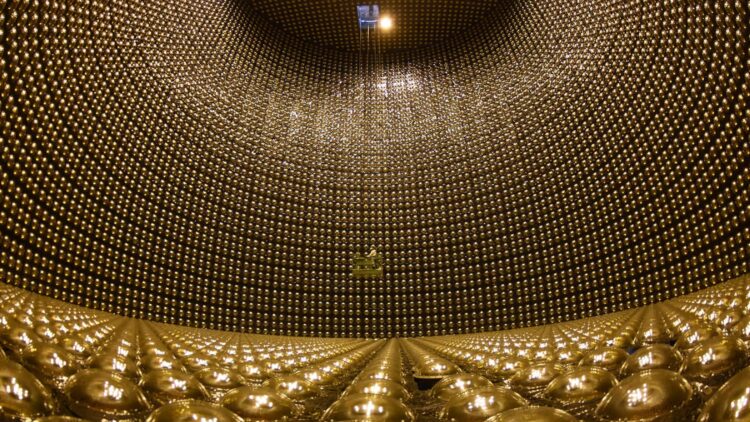In an effort to understand the universe, such as the nature of dark matter and remnants of the Big Bang, Japan’s Super-Kamiokande (SK) experiment stands as a monumental milestone in neutrino research. Nestled over 3,000 feet underground at the Kamioka Observatory in Hida, this immense water Cherenkov detector contains 50,000 tons of purified water and is fitted with 11,000 photo-multiplier tubes (PMTs). By detecting neutrinos—small, elusive particles generated by cosmic events—SK seeks to unlock secrets about the cosmos.
The Super-Kamiokande experiment is a technological marvel
Launched in April 1996, SK was designed to be the world’s largest water Cherenkov detector, featuring a cylindrical stainless steel tank with a diameter of 129 feet and a height of 136 feet.
Its primary purpose is to clarify the properties of neutrinos by observing solar, atmospheric, and artificial neutrinos. The detector’s fiducial volume is 22.5 kilotons, enabling it to capture a diverse range of neutrino interactions.
Currently in its fourth phase, referred to as SK-IV, the experiment is preparing to shift to the SK-Gd phase, during which gadolinium will be introduced to enhance neutron tagging efficiency. This upgrade aims to enable the first observation of supernova relic neutrinos, further enriching our understanding of the universe’s early moments.
The quirky world of neutrinos: How detection works
Neutrinos are among the universe’s lightest particles, nearly massless and incredibly abundant. They are produced by a variety of cosmic events, including the aftermath of the Big Bang, stellar processes, and even nuclear reactors here on Earth. Being able to pass through matter, neutrinos can provide important insights on the processes occurring within stars and throughout the universe.
The discovery of neutrino oscillation—whereby neutrinos change type during their flight—changed our understanding of these particles. This phenomenon was first observed in atmospheric neutrinos in 1998, followed by solar neutrinos in 2001 and artificial neutrinos in 2011.
SK utilizes an advanced detection method based on Cherenkov radiation. When a neutrino interacts with water, it can produce charged particles that travel faster than the speed of light in water, resulting in a faint glow known as Cherenkov light. This light is captured by the PMTs lining the tank, which gather information on the energy, direction, and type of the interacting particles.
In order to minimize background noise from cosmic ray muons, the detector is shielded by a mountain, effectively allowing it to concentrate on the infrequent neutrino events. The outer PMTs help distinguish between neutrino interactions and other charged particle events, guaranteeing precise measurements of neutrino properties.
SK and neutrinos: The quest for fundamental answers to our universe
In addition to detecting neutrinos, SK aims to tackle scientific questions about the universe, including the nature of dark matter and the conditions of the early universe.
The experiment also investigates proton decay, a phenomenon predicted by Grand Unified Theories (GUTs) that propose a unification of the fundamental forces of nature.
Should proton decay be detected, it would serve as crucial evidence for GUTs, helping to explain the asymmetry of matter and antimatter in the universe. This could elucidate why our universe is primarily composed of matter, a question that has long puzzled scientists.
The SK experiment continues to be a key player in the field of neutrino research, offering valuable insights into the basic building blocks of creation. By harnessing the power of 50,000 tons of water and cutting-edge detection technology, Japan is poised to trap traces of the Big Bang, deepening our understanding of the cosmos. As SK progresses through new phases and upgrades, it promises to unravel even more mysteries lying at the core of the universe.

